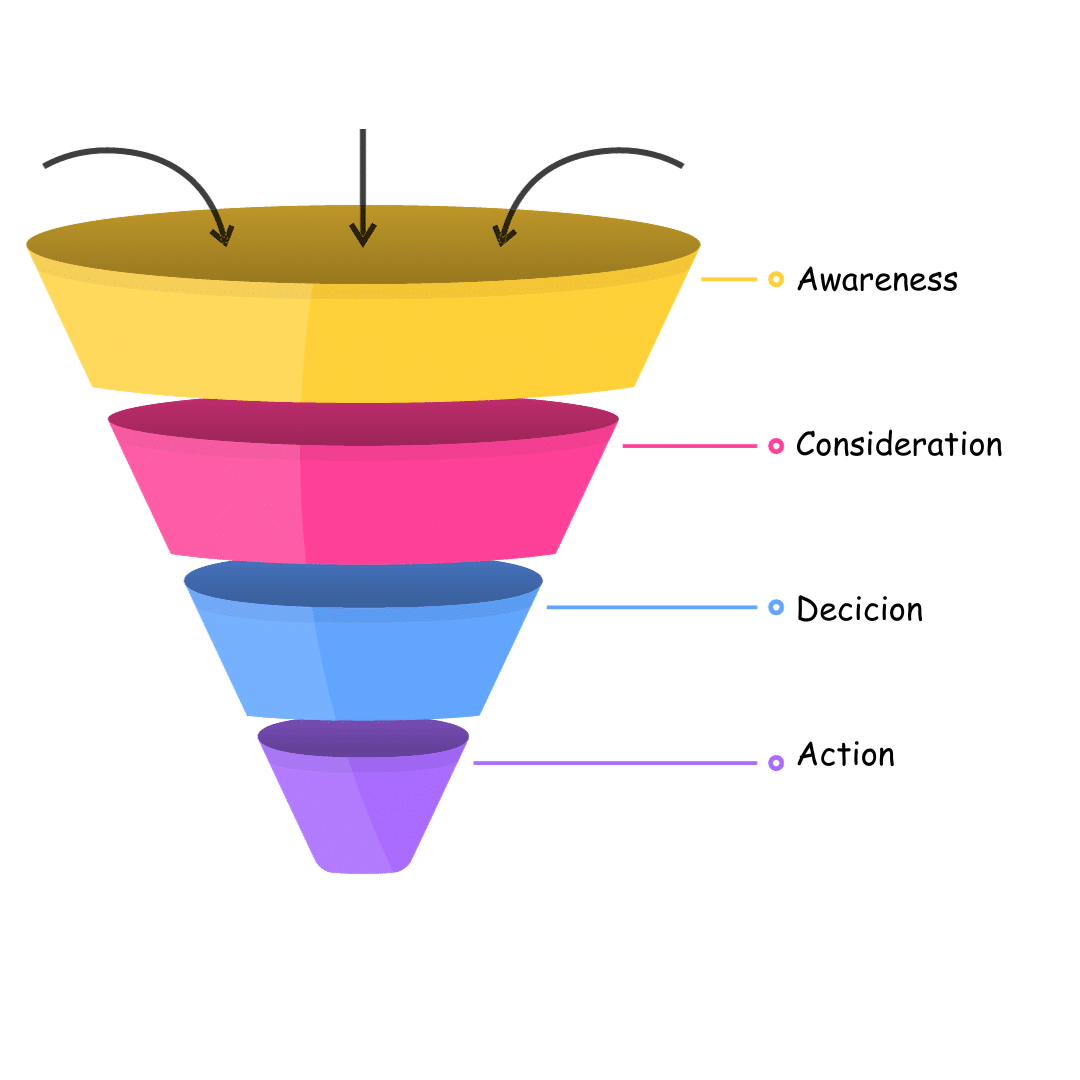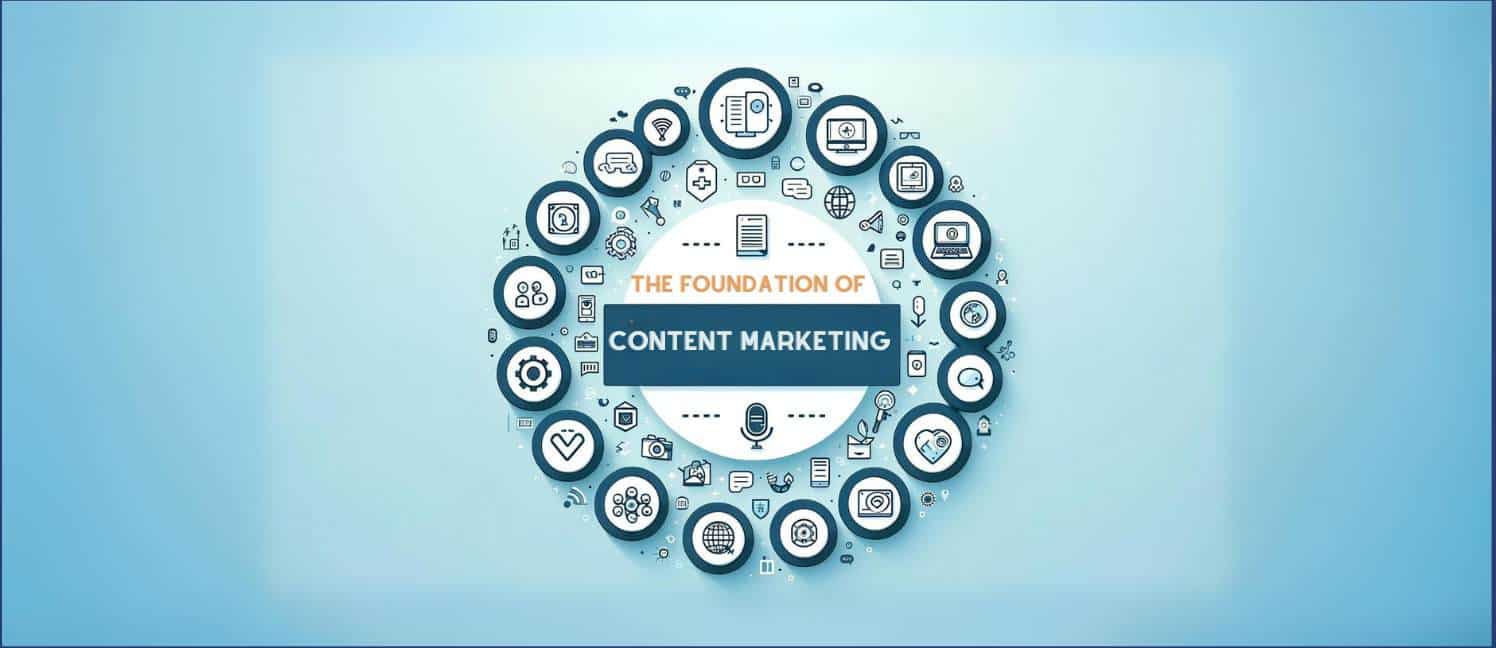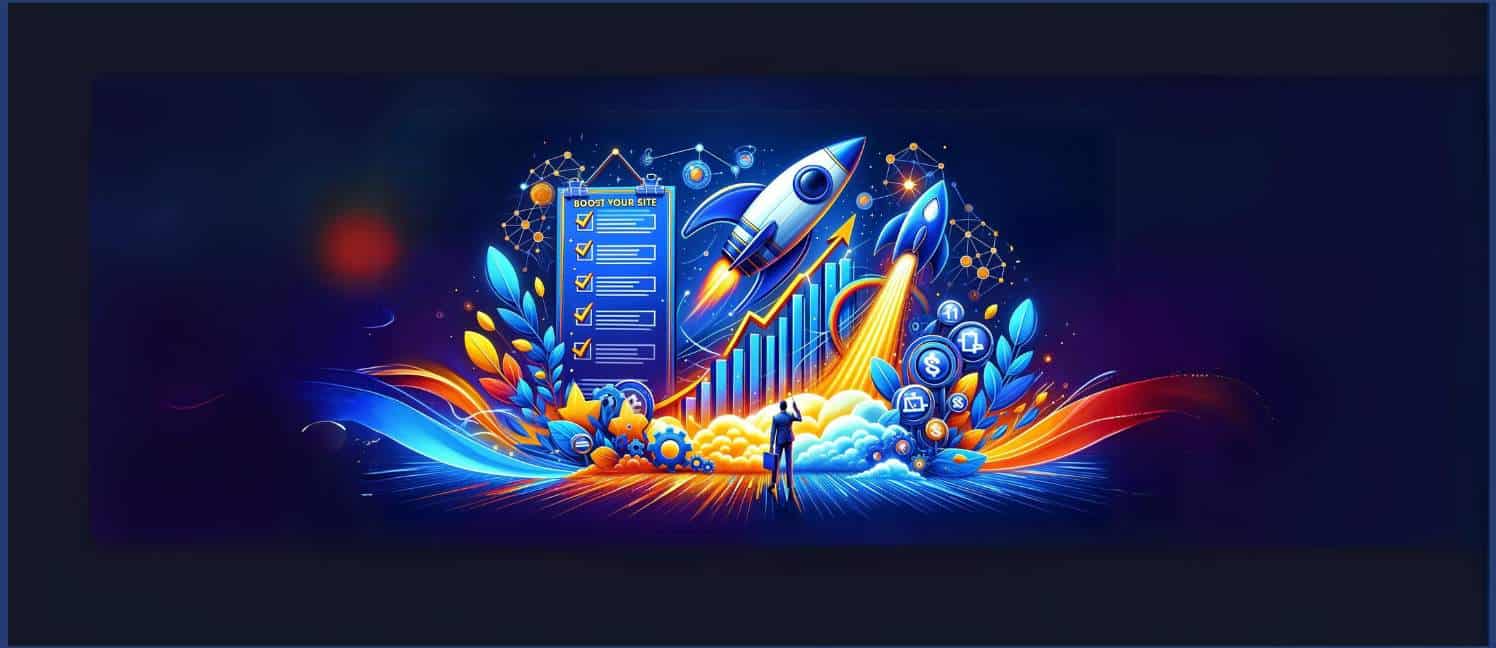Hourglass marketing funnel is a model focused on the entire customer journey. Unlike the traditional funnel, it doesn’t end when a customer purchases. Instead, it strives to retain and convert customers into brand advocates.
The hourglass strategy acknowledges that buying isn’t the end of a customer’s lifecycle. With effective post-purchase engagements, brands can cultivate long-term relationships that help realize better lifetime customer value.
Before building an hourglass funnel, let us step back and establish what a marketing funnel is all about.
What Is a Customer Marketing Funnel?
A marketing funnel outlines the journey users take to engage with your brand. The funnel provides the framework to connect and engage potential customers, driving them to the ultimate destination- buying. The primary stages are:
- Awareness stage– users first learn about your brand and what it offers.
- Consideration– They consider how your solutions solve their pain points, including a competitive analysis to establish if your brand is the best fit
- Decision– users weigh more information, including prices. Content such as a clear call to action helps tip the potential customer in your favor.
- Action– the potential customer decides to buy. A smooth purchase process makes it easier for the user to buy and more likely to return.

Traditional marketing funnel only focuses on the above stages. They are more attuned to a sales funnel, limited to awareness and customer conversion, which is not sustainable in the modern, highly competitive market.
What Are the Two Types of Marketing Funnel?
The two main types of funnels are sales funnel and marketing funnel. They are almost the same, with the main distinction being the end goal.
- The sales funnel focuses on converting perspectives into customers.
- The marketing funnel focuses on casting the marketing efforts wider to attract and nurture more prospective customers and move them through the buyer’s journey.
The hourglass funnel is more of both while focusing on nurturing ongoing relationships even after a user buys.
What Is the Hourglass Marketing Strategy?
While traditional marketing strategy focuses on acquiring new customers, hourglass strategy goes the extra mile. It focuses on attracting, converting, retaining, and encouraging advocacy.
The hourglass model aims to create a positive ongoing customer experience throughout their lifecycle. It is a cyclical approach that touches the customer journey, including post-purchase support, loyalty, and advocacy. The approach fosters long-term relationships, which delivers better customer lifetime value.
What Is the Difference Between a Funnel and an Hourglass Funnel?
The primary distinction between the traditional and hourglass marketing funnel isn’t just in the shape. Hourglass funnel is wider at the bottom, much like at the top, because it doesn’t view a customer’s journey as complete when they buy.
The hourglass model emphasizes the need for customer satisfaction. The objective is to turn satisfied customers into long-term loyal customers. The loyalty’s goal is not just to improve customer retention rates. Marketing hourglass strategy also strives to turn the users into brand advocates.
The approach means that your business continues to engage a customer after a purchase. This gives customers a more positive experience, which keeps your brand on top of their minds. Such customers are likelier to return for repeat purchases.
Even after a repeat business, the engagement doesn’t stop. The strategy focuses on expansion by leveraging the loyal user base. As customers return for more, they become a part of the brand. They identify with your business, which provides an opportunity to encourage them to spread good word about your products/services and positive experiences.
Customer advocacy is a huge asset. Leveraging user-generated content (UGC) delivers the social proof online businesses need to thrive. UGC is more authentic than brand-sponsored content, meaning other users will easily trust your business. Such credibility gives your business an edge over the competitors, making it easier to attract more potential customers.
Moreover, engaged, loyal customers are easier to market to and retain since they already feel a part of the brand. Such contributions make the hourglass marketing funnel a more effective strategy.
The Hourglass model doesn’t sabotage your efforts like the traditional approach that “loses” customer attention after a purchase. The improved customer satisfaction, retention rates, and conversion into brand advocates keep expanding your user base. This facilitates long-term business growth.
What Is the Hourglass Marketing Funnel Structure?
The hourglass funnel looks exactly like an hourglass. Like the traditional marketing funnels, the structure has the following:
- Top-of-the-funnel (TOFU) – loaded with educational content that helps users understand your brand. Ideal content types include blog posts, social media posts, infographics, podcasts, video content, and eBooks. Attending marketing events also helps.
- Middle (MOFU) – evaluation stage where brands provide more details about their products/services. Here, you strive to win the prospective customers’ trust and show them why your brand solves their problems. Common content types include emails, white papers, case studies, and helpful downloadable resources.
- Bottom (BOFU) is the conversion stage, which requires brands to build the prospective clients’ confidence. You focus on providing clear reasons the client should choose your business. Comparisons, customer reviews and stories, and demos/free trials help at this stage. A clear call to action and a seamless purchase process boost conversion rates.
Traditional marketing funnels usually end at conversion, but the hourglass model has more levels. They are:
- Use – after the purchase, the client uses your product/service. At this point, you can keep them hooked with personalized content and ongoing customer service. Content such as technical specifications, FAQs, and tips to optimize product use are ideal for the use stage.
The user has an easier time squeezing the most of the product and realizing the optimal value of their investment, which helps improve customer satisfaction. You also encourage the user to leave feedback and, where necessary, address any post-purchase concerns.
- Expansion and retention – you keep the users engaged by maintaining contact. The ongoing interactions encourage current customers to make repeat purchases. You can also consider additional upsell/cross to encourage more purchases from your collection.
The engagement improves retention rates, and as you tip the existing customers to buy other items from your business, you expand their interest. Expansion and retention improve lifetime customer value, translating to a more profitable business.
- Advocacy stage – loyalty and evangelism are arguably the most notable contributions that make the hourglass model a must-consider in every digital marketing strategy. At this point, the focus is delivering content to encourage happy clients to refer others to your brand.
A happy customer is more than willing just to leave a review. They can deliver UGC and supercharge the social proof needed for credibility. You can further foster loyalty and brand evangelism with loyalty offers and referral bonuses.
The incentives can prompt the users to stay engaged, write positive client testimonials, and refer their family and friends to your business. Such contributions make it easier to grow a huge and connected loyal customer base, the most valuable asset businesses strive to get.
The Customer Buying Journey: Why Is It Shaped as an Hourglass?
As illustrated in the above structure, it is clear that the model’s shape is per its ongoing approach, touching the entire customer lifecycle. It widens at the top and bottom, accounting for the broader stages of:
Customer acquisition is important as brands strive to attract prospective customers and move them through the funnel to the final destination- purchasing.
Retention measures to keep existing customers satisfied and loyal. The objective is to encourage them to continue doing business with you and become brand advocates.
The model narrows at the middle, associated with the focused efforts to convert leads into customers. The efforts also focus on engaging the user during the purchase and use phases.
How to Build Your Marketing Hourglass
Building an effective funnel for your marketing hourglass approach significantly hinges on audience research. You need audience knowledge to develop a customer journey stages model that addresses their pain points at each step. Such a model holds the user’s hand at each point and smoothly transitions them to the next. This includes keeping active customers engaged with your brand. Here is how to build the hourglass marketing funnel.
Attract Prospective Customers
The awareness stage is about capturing your target audience‘s attention and attracting them to your brand. An effective approach to gaining extensive reach and creating brand awareness entails targeting the users where they are. It means you need to craft and distribute relevant content through various channels. The common ways to do this include:
- Social media marketing
- SEO (search engine optimization) and content marketing
- Sponsored ads
Engage the Users
The consideration stage is when the potential customers weigh what you offer against your competitors. At this point, you need to keep them interested and showcase your brand’s uniqueness.
You can engage the audience with helpful content highlighting your brand story and how you solve their problem. Offer personalized experiences and focus on building interactions. This way, you’ll build healthier relationships with potential customers, making moving them to the next stage easier.
Converting the Leads
The conversion stage requires compelling offers that emphasize the value the user gets. Here, you need clear calls to action that prompt the prospective customer to act on their decision to purchase. You also must focus on providing a seamless buying process, or else they’ll abandon the cart.
Hourglass marketing funnel focuses more on providing personalized customer support. This improves conversion rates and creates a positive post-purchase experience that takes the user to the next phase.
Ongoing Support and Engagement
After the purchase, the customers use your products. Ongoing support and engagement help the brand offer the active customers maximum value. For instance, a customer may need more information to use a product optimally. For instance, you can offer one-on-one interactions customized to the user’s situation. This creates a positive experience, enhancing customer satisfaction rates.
Advocacy Stage
Happy customers are invaluable since they will likely stick by your brand. Moreover, you can easily encourage active customers to become advocates. For instance, you can ask them to share the positive experiences they’ve realized when interacting with your brand.
Satisfied customers can easily leave positive reviews, testimonials, and UGC. Such content acts like word-of-mouth messages. This is more effective than brand-sponsored content such as ads. You can also ask existing clients to refer others to your brand, which they’ll happily do, considering the positive experiences and high satisfaction rates.
Loyalty Stage
A huge brand-loyal customer base is in every marketing and sales team’s dreams. It is achievable with the hourglass model since it is focused on long-term relationships. You can foster brand loyalty by continuing to offer the existing clients value. For instance, you can maintain ongoing personalized communication and offer exclusive offers.
Brand-loyal customers deliver better lifetime value as they keep buying from your business. Moreover, they’re happy to pay a little more since you offer value that keeps them glued to your brand.
What Is an Example of an Hourglass Funnel Strategy in Marketing?
Let’s say your brand is a Software as a service (SaaS) business. Using the hourglass marketing funnel, you can attract customers using infographics, introductory videos or audio podcasts, and ads. You then engage them with informative and engaging social media, eBooks, and blog content.
The content attracts and nurtures leads, driving them to the purchase stage. You keep the audience hooked with relevant content, clear calls to action, and competitive offers. This improves the conversion rates, which you follow up with personalized customer support.
As a software business, support can include onboarding assistance, personalized tutorials, and ongoing customer service. You then foster advocacy and loyalty with exclusive features. Such incentives can encourage customers to share user-generated content, leave positive reviews, and refer others.
The model creates a cycle of attracting and converting prospective customers, engaging them to establish loyalty, and leveraging their advocacy to attract new customers.
ContentGo’s Quality Content: The Main Hourglass Marketing Funnel Ingredient
Digital marketing strategy requires more than an elaborate model. Your hourglass marketing funnel can only generate qualified leads and convert them if backed by high-quality content. With the right content, you can facilitate evergreen lead generation and keep the top of the funnel loaded. This is more so with effective content distribution and promotion strategy that expands your reach.
Relevant content attracts and facilitates better movement through the funnel. It helps minimize lead leakage, enhancing conversion and retention rates.
Content creation can be daunting, but not when you turn to professionals. Outsourcing content creation to ContentGo ensures you utilize high-quality, search-engine-optimized content that resonates with your target audience.
Let ContentGo handle all your content creation needs, from blog posts to category, product, and Meta descriptions, to name a few. The content will enrich your hourglass marketing funnel, allowing you to win, retain, and turn more customers into loyal brand advocates.
Register today and leverage ContentGo’s experienced professionals backed by cutting-edge content creation technologies.












